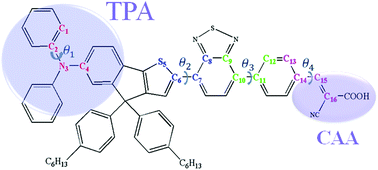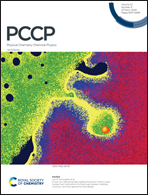Effect of graphene between photoanode and sensitizer on the intramolecular and intermolecular electron transfer process†
Abstract
The main goal of this work is to investigate the effects of a graphene layer between the photosensitive layer and semiconductor substrates on the electron transport performance of dye-sensitized solar cells from the perspective of intramolecular arrangement and interfaces. The benzothiadiazole sensitizer YKP-88 is used as the photosensitive layer and the influence of the graphene layer on the short-circuit current density (Jsc) and open-circuit voltage (Voc) is also discussed by exploring the frontier molecular orbitals, intramolecular charge transfer, weak interaction, interfacial electron dynamic propagations and other microscopic parameters after the anchoring of the graphene layer. The results demonstrate that the graphene layer can accelerate the electron injection of dye molecules into the semiconductor substrate, which not only has a qualitative reduction in injection time, but also has a qualitative change in the increase of the injection amount. In addition, it is also found that the graphene layer increases the stereoscopic effect, the absorption of long wavelength (>700 nm) photon flu and the amount of electron injection into the photoanode, which benefits the intramolecular charge transfer and increases the Jsc and Voc of solar cells. The combination of intermolecular and interfacial perspectives indicates that the appropriate configuration of graphene layers can effectively improve the photoelectric conversion efficiency of dye-sensitized solar cells.



 Please wait while we load your content...
Please wait while we load your content...